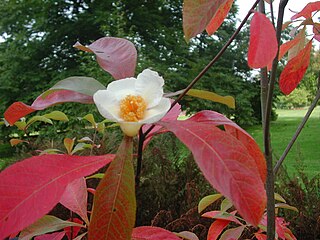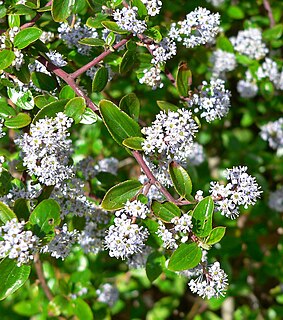
The brown-cheeked fulvetta, is included in the family Alcippeidae. It was earlier also known as the quaker babbler.

Franklinia is a monotypic genus in the tea family, Theaceae. The sole species in this genus is a flowering tree, Franklinia alatamaha, commonly called the Franklin tree, and native to the Altamaha River valley in Georgia in the southeastern United States. It has been extinct in the wild since the early 19th century, but survives as a cultivated ornamental tree.

The colorful puffleg is an Endangered species of hummingbird in the "brilliants", tribe Heliantheini in subfamily Lesbiinae. It is endemic to Colombia.

The dragon tube-nosed fruit bat is a species of bat in the family Pteropodidae. It is found on both sides of New Guinea: West Papua, Indonesia and Papua New Guinea. It is slightly smaller and very similar in appearance to N. albiventer, differing by having more profuse, dark spotting on its wing membranes, and smaller shorter canines. The similarity between the species has been a source of possible misidentifications. The records of this species from Papua New Guinea are associated with freshwater swamps and rivers.
Lasianthus ciliatus is a species of plant in the family Rubiaceae. It is endemic to Tamil Nadu in India.

Lasianthus is a genus of flowering plants in the family Rubiaceae. They are tropical subshrubs, shrubs, or rarely, small trees. They inhabit the understory of primary forests. The flowers are used extensively in the floral industry.
Lasianthus gardneri is a species of plant in the family Rubiaceae. It is endemic to Sri Lanka.
Lasianthus grandifolius is a species of flowering plant in the family Rubiaceae. It is endemic to Tanzania.
Lasianthus pedunculatus is a species of plant in the family Rubiaceae. It is endemic to Tanzania.
Lasianthus rhinophyllus is a species of plant in the family Rubiaceae. It is endemic to Sri Lanka.
Lasianthus rostratus is a species of plant in the family Rubiaceae. It is endemic to Kerala in India.
Lasianthus tomentosus is a species of plant in the flowering plant family Rubiaceae. It is found in Indonesia and Singapore. It is possibly threatened by habitat loss. Its conservation status is uncertain because of the difficulty of identifying it. Several botanical works have mistakenly described Lasianthus trichophlebus, var. latifolius as Lasianthus tomentosus.
Lasianthus varians is a species of plant in the family Rubiaceae. It is endemic to Sri Lanka.
Lasianthus wallacei is a species of plant in the family Rubiaceae. It is endemic to Tanzania.
Lasianthus capitulatus is a species of plant in the family Rubiaceae. It is endemic to southern India.

Ocotea porosa is a species of plant in the Lauraceae, often placed in the related genus Phoebe. It is commonly called imbuia or Brazilian walnut because its wood resembles that of some walnuts. The tree is a major commercial timber species in Brazil, used for high-end furniture, mostly as decorative veneers, and as flooring. The wood is very hard, measuring 3,684 lbf on the Janka scale. The wood is also fragrant with hints of nutmeg and cinnamon. The tree is also a popular horticultural tree in subtropical regions of the world. In its native habitat it is a threatened species.

Ceanothus oliganthus is a species of shrub in the family Rhamnaceae known by the common name hairy ceanothus or hairy-leaf ceanothus.

A vulnerable species is a species which has been categorized by the International Union for Conservation of Nature that is threatened with extinction unless the circumstances that are threatening its survival and reproduction improve.
As of July 2016, the International Union for Conservation of Nature (IUCN) lists 238 conservation dependent species. 0.29% of all evaluated species are listed as conservation dependent. The IUCN also lists seven subspecies and five varieties as conservation dependent.

Nyssa biflora, commonly referred to as the swamp tupelo, or swamp black-gum is a species of tupelo that lives in wetland habitats. Swamp tupelo grows chiefly in the coastal plains from Delaware, eastern Maryland, and southeastern Virginia, south to southern Florida and west to eastern Texas. Its range extends north up the Mississippi Valley to southern Arkansas and west and south Tennessee.









